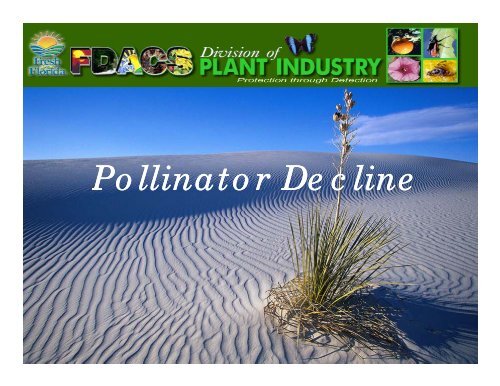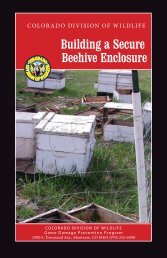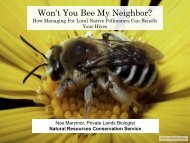Presentation by G.W. Hayes Jr - Colorado State Beekeepers ...
Presentation by G.W. Hayes Jr - Colorado State Beekeepers ...
Presentation by G.W. Hayes Jr - Colorado State Beekeepers ...
Create successful ePaper yourself
Turn your PDF publications into a flip-book with our unique Google optimized e-Paper software.
Pollinator Decline
Apiary Industry<br />
Under Siege From Pests,<br />
Diseases and Now Something Called<br />
CCD
Honey Bee Colony<br />
Mortality<br />
• 2006 – 2007 32%<br />
• 2007 – 2008 36%<br />
• 2008 – 2009 29%
Agricultural Acres Planted With Pollinator Dependent<br />
Crops Has outpaced the availability of Pollinators.
Colony Losses<br />
• Globalization and Homogenization of pests,<br />
predators, parasites, diseases and honey<br />
bees<br />
• Production Agriculture<br />
• Production Bee Keeping<br />
• Pesticide id misuse<br />
• Eliminating “productive” locations to place<br />
honey bee colonies<br />
• Entomophobia<br />
• Low Honey Prices<br />
• Low Pollination Prices
The Parasitic Varroa Mite
• Think of Varroa as a dirty needle
Viruses
Nosema / Microsporidian
Small Hive Beetle
Chemicals AG
Production Beekeeping
Beekeeper Chemicals
Chemical Residue in wax<br />
100<br />
90<br />
80<br />
70<br />
60<br />
50<br />
40<br />
30<br />
20<br />
0<br />
10<br />
Coum maphos<br />
Fluva valinate<br />
Chlorpy pyrifos<br />
Coumaphos<br />
Oxon<br />
Chloroth thalonil<br />
Endosulfan n ( (total)<br />
Boscalid<br />
Dicofol<br />
Esfenva valerate<br />
Azoxyst strobin<br />
Vinclo clozolin<br />
Pesticides
Entomophobia<br />
• Loss Bee locations
Low Honey Prices
Low Pollination Prices
The CCD Factor<br />
D. vanEngelsdorp<br />
NRi N. Rice<br />
D. vanEngelsdorp<br />
N. Rice
Symptoms CCD Colonies<br />
• The normal ratio of bees and brood in a Honey Bee<br />
colony is, in a rough general sense, 2 adult Honey<br />
Bees to 1 cell of sealed brood<br />
• When the ratio reverses to 1 adult Honey Bee to 2-3<br />
cells of sealed brood…this is the latest definition of<br />
CCD<br />
D. vanEngelsdorp
Symptoms CCD Colonies<br />
• The queen is always present<br />
• Have a very low number of varroa or<br />
absence of varroa tracheal mites are<br />
found in less than 10% of samples<br />
• Nosema is found in less than 50% of<br />
samples
Pesticide Analysis<br />
• USDA Agricultural<br />
Marketing Service National<br />
Science Lab<br />
- Screening for 171 pesticides<br />
- Detection at ppb levels<br />
• Colony Matrices<br />
- Wax, bee bread and trapped pollen,<br />
adult bees, brood, royal jelly<br />
• Samples from large and small<br />
beekeeper eepe operations o of seven<br />
states<br />
M.T.Frazier
Samples Analyzed 2007-’08<br />
08<br />
• 699 samples<br />
• From<br />
• CCD study<br />
• Apple orchard study<br />
• Migratory study<br />
• Beekeeper submitted samples
Honey Bees - Excellent Indicator<br />
of Environmental Pesticides<br />
Acephate<br />
Acetamiprid<br />
Aldicarb sulfone<br />
Aldicarb sulfoxide<br />
Allethrin<br />
Amicarbazone<br />
Amitraz (2,4-DMA)<br />
Amitraz (2,4-DMPF)<br />
Atrazine<br />
Azinophos-methyl<br />
Azoxystrobin<br />
Bendiocarb<br />
Bifenthrin<br />
Boscalid<br />
Captan<br />
Carbaryl<br />
Carbaryl (1-Naphthol)<br />
Carbendazim<br />
Carbofuran, 3-hydroxy<br />
Carfentrazone<br />
Chlorfenapyr<br />
Chlorothalonil<br />
Chlorpyrifos<br />
Coumaphos<br />
Coumaphos-Chlorferone<br />
Coumaphos oxon<br />
Cyfluthrin<br />
Chlthi Cyhalothrin (ttl) (total)<br />
Cypermethrin<br />
Cyprodinil<br />
Deltamethrin<br />
Diazinon<br />
Dicofol<br />
Difenoconazole<br />
Diflubenzuron<br />
Dimethomorph<br />
Diphenylamine<br />
Endosulfan 1<br />
Endosulfan 2<br />
Endosulfan sulfate<br />
Esfenvalerate<br />
Etoxazole<br />
Fenbuconazole<br />
Fenhexamid<br />
Fenpropathrin<br />
Fluvalinate<br />
Heptachlor<br />
Hexachlorobenzene<br />
Imidacloprid<br />
Imidacloprid olefin<br />
Imidacloprid, 5-hydroxy<br />
Indoxacarb<br />
Malathion<br />
Methidathion<br />
Methoxyfenozide<br />
Methyl parathion<br />
Metolachlor<br />
Metribuzin<br />
Myclobutanil<br />
Norflurazon<br />
Oxamyl<br />
Oxyfluorfen<br />
f<br />
p,p'-DDE<br />
Pendimethalin<br />
Permethrin<br />
Phosmet<br />
Pyraclostrobin<br />
Pyrethrins<br />
Pyrimethanil<br />
Quintozene (PCNB)<br />
Sethoxydim<br />
Simazine<br />
Tebuconazole<br />
Tebufenozide<br />
Tebuthiuron<br />
Tetramethrin<br />
Thiabendazole<br />
Thiacloprid<br />
Tribufos<br />
Trifloxystrobin<br />
Trifluralin<br />
Vinclozolin
Multiresidue Pesticide Analysis on US Samples<br />
2007-0808<br />
• Up to 31 different pesticides per sample, 6+ average<br />
• Only 3 samples lacked detections<br />
• Found 73 different pesticides and 9 other metabolites<br />
-12 pyrethroids, 10 organophosphates, 5 carbamates,<br />
3 neonicotinoids<br />
- 3 insect growth regulators, 2 organochlorines, 2 chlorinated cyclodienes,<br />
- 20 fungicides, 12 herbicides, 2 acaricides, 1 synergist, 1 misc.<br />
• At least 14 of these are systemic pesticides
What impact are they<br />
having?<br />
• Toxic effect (multiple pesticides) (Sara Ashcraft)<br />
• Synergistic insecticides + fungicides<br />
• Behavioral effects<br />
• Learning and retention (Daniel Schmehl)<br />
• Comparison of European and African bees<br />
• Physiological i l effects<br />
• Immune system function (Diana Cox-Foster)<br />
• Longevity
Outcomes of Beehive Pesticide Analysis<br />
• No commodity has had as many detections at such high amounts in so few<br />
samples over such a short time as has bee pollen<br />
• Highest detections were in-house varroacides, fluvalinate and coumaphos, but<br />
about 80 other pesticides and metabolites found<br />
•Pyrethroids known to impact foraging behavior dominate<br />
• No individual chemical is likely to explain CCD<br />
• Impacts of multiple pesticide residues in bee food most likely will be via<br />
synergistic interactions at sublethal levels on key behaviors/physiology<br />
• Systemic or other fungicides occur at levels that may synergize with<br />
pyrethroids, organophosphates or neonicotinoids.<br />
• Role of pesticides and diseases like IAPV in CCD remains to be reconstituted in<br />
lab bioassays at relevant doses
Why Neonicotinoids and<br />
Fungicides?<br />
id • Environmental contaminants are a research priority<br />
• Neonicotionoids - a relatively new class of<br />
pesticides (imadicloprid introduced in 1991)<br />
• now the most widely used class of pesticides in US<br />
• Most are known to be highly toxic to bees<br />
• EPA fact sheet, numerous studies, product labels<br />
• Neonicotinoids and some fungicides are synergistic<br />
= more toxic<br />
Funding:<br />
Florida <strong>State</strong> and Tampa Bay <strong>Beekeepers</strong> Associations<br />
National Honey Board, Other <strong>State</strong> and local associations
Difficulty of Assessing<br />
Impact<br />
• Geographical wide-spread (world-wide) wide)<br />
• Soil types<br />
• Wide variety of crops, ornamental, forest, turf and structural<br />
situations<br />
• Varied application techniques<br />
• seed treatment, foliar spray, granular soil application and liquid<br />
drench<br />
• Increasing rate at which they are being used<br />
• Now the most widely used class of pesticides in the US<br />
• Complex behavior and activities of honey bees
Evidence of<br />
Fungal<br />
Conditions<br />
D. vanEngelsdorp
Pathogen<br />
D. vanEngelsdorp
Amoeba<br />
Disease<br />
D. vanEngelsdorp
Nodules<br />
• Iridescent Virus?
Area of Focus<br />
Honey Bee Health Challenges<br />
Primary Stress<br />
Varroa Mites<br />
Management<br />
Nutrition<br />
Pesticides<br />
Secondary Pathogens<br />
Nosema<br />
Fungi
Ecosystems Stability<br />
- Complex relationships<br />
- Interconnected elements<br />
species, water, soil<br />
- All groups/guilds are important<br />
and play critical roles<br />
- Balanced equilibrium<br />
ALSO<br />
- Dynamic; can change, respond<br />
to and often recover from<br />
negative inputs or damage
QuickTime and a<br />
decompressor<br />
are needed to see this picture.<br />
The herbicide atrazine is linked<br />
to reproductive problems in frogs<br />
EPA commissioned study - no<br />
connection found<br />
2008 Study<br />
Jason Rohr Univ. of S. Florida<br />
and others<br />
1980’s worldwide decline<br />
in frog populations<br />
Disease and habitat<br />
destruction are blamed<br />
Atrazine kills off floating mats of<br />
algae, allowing algae on the<br />
pond bottom to thrive<br />
Snails flourish;flatworm host<br />
Flatworms parasitize frogs!
Ecosystems Instability<br />
The balance can be “tipped” resulting in a cascade of<br />
negative ecological consequences = serious damage.<br />
Pesticides associated with tipping the balance.
Honey Bee Colony “Ecosystems”<br />
- Complex relationships<br />
- Interconnected elements<br />
- queens, workers, comb, food resources<br />
- Groups/castes play critical roles<br />
- Balanced equilibrium<br />
ALSO<br />
-worker/brood ratios<br />
-nurse/house/forager bee ratios<br />
S. Camazine<br />
- Dynamic; can change, respond to<br />
and often recover from negative inputs<br />
- lost field force = precocious foragers
BUT the balance can be “tipped” resulting in a cascade<br />
of negative consequences = serious damage<br />
population declines? CCD?
Why is CCD<br />
Important?
But Does Any of This<br />
Matter?<br />
• “You, Me and all of your Neighbors know<br />
food comes from the grocery store.”
USDA Projections<br />
• 40% of our Veggies will Come from Non-<br />
US sources <strong>by</strong> 2012<br />
• US will be a Net Food Importer in 50<br />
years
Thank You from Sunny<br />
Florida





